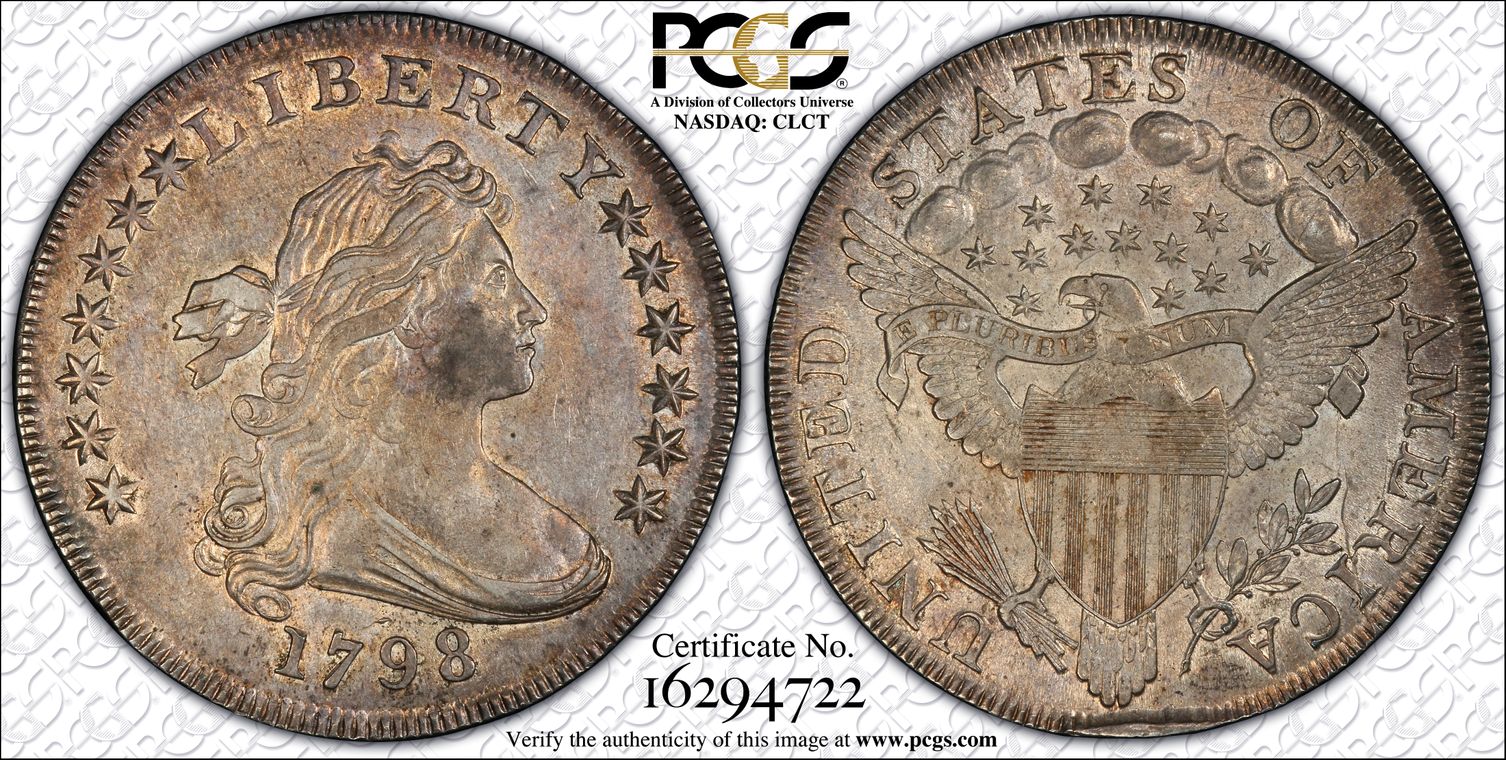1798 $1 BB-102 AU58 认证号16294722, PCGS号40019
拥有者评论
BB-102: ex: Hesselgesser - Walt Husak
专家评论
Q. David Bowers
The following narrative, with minor editing, is from my "Silver Dollars & Trade Dollars of the United States: A Complete Encyclopedia" (Wolfeboro, NH: Bowers and Merena Galleries, Inc., 1993). Note: the Notable Specimens list should be used with caution - it has been updated in my 2013 edition of "The Encyclopedia of United States Silver Dollars 1794-1804."B-20. H-20.
OBVERSE 6: Wide date, 11 mm. across at widest part. 1 close to curl, 8 near bust but does not touch. Two upper stars near Land Y. First star nearly 4 mm. from hair. Ray of last star points to lower edge of a denticle. The obverse displays a prominent die chip between the left side of the 9 and the bust. The bottom stand of the T in LIBERTY is repunched.
Obverse die used to strike 1798 BB-102, BB-103, and BB-107.
REVERSE E: See description under 1798 BB-94. From same die used to strike BB-94 and BB-95. The die crack that developed on BB-95 from right wing down through I in AMERICA to border has now become heavier. Another crack is below ER in AMERICA. The BB-102 reverse also has a number of die dots in and around the second cloud from the right plus a small crack from the 0 to the F in OF, to the lower part of the first S in STATES. Incused denticles (clash marks from the obverse) are often visible above ES and OF. Faint clash mark from bust is seen through OF.
Reverse die used to strike 1798 BB-94 (earliest state), BB-95 (intermediate state), and BB-102 (final state).
DIE STATES:
Die State I: Die state as described above for BB-102.
Die State II. Rim crack below eagle's tail just beginning. Die State III: Later state with a heavy rim break (which in its early development is often mistaken for a bruise or a nick) below the eagle's tail, extending to the last A in AMERICA.
Die State IV: The obverse die lump midway between center of date and bust becomes heavier. Reverse rim break enlarges.
Die State V: The reverse has an extended reverse break which travels through ICA in AMERICA and nearly touches the eagle's tail. Die State V is extremely rare in any grade.
COLLECTING NOTES: BB-102 is in the medium range of scarcity among silver dollars of 1798. Probably somewhere around 75 to 125 are known. The variety is one of only a few with an average grade below the VF level. A review of auction appearances demonstrates that here is a variety for which EF and AU are remarkable grades. Exactly why 1798 BB-102 should be so elusive in any grade above VF is one of those mysteries that makes collecting early dollars so interesting. The answer probably lies in the method of distribution. I have no way of knowing, but perhaps most specimens were sent away from urban centers and saw hard use in the American hinterlands, which in the 1790s included just about everywhere except the eastern coastal cities.
NOTABLE SPECIMENS:
Boyd Specimen. AU-50. Numismatic Gallery, World's Greatest Collection, F.C.C. Boyd, 1945:45. "Barely circulated. Cabinet friction on high spots."
Kagin Specimen. AU-50. Kagin's, CSNS Convention Sale, 1979:362. "Unlisted die break on edge below eagle's tail. AU-50 with traces of lustre, nice strike."
Miller Specimen. EF-40. Warren Miller Collection. Weak reverse with adjustment marks in shield.
Fairbanks Specimen. EF-40. Stack's, Fairbanks Collection (formed by Ben Koenig), 1960:545. "EF choice. Mint lustre."
Ruby Specimen. VF-25. M.H. Bolender, Dr. Charles Ruby, Superior Galleries, ANA Convention Sale, 1975: 879. "Reverse rim break below eagle's tail. Pearl gray tone and partly iridescent reverse. Weakly struck up in the centers as usual and slightly off center. Unlisted die state."
Willasch Specimen. VF-25. Superior Galleries, H. Roland Willasch Collection, 1990:496. "Medium steel color and well struck but for the central devices. Some minor adjustment marks in the central reverse contribute to the weakness. A heavy rim cud has developed below the eagle's tail to the A in AMERICA. One area on the rim near Liberty's bust may have been worked on, as the rim pulls in at that point on the obverse and reverse. Rare die state. The break from the rim through the I of AMERICA extends to the tip of the scroll and another parallels it along the base of E and through R.
Baldenbofer Specimen. F-15 net. (VF-25, edge damaged). W.G. Baldenhofer to Stack's, Farish-Baldenhofer Sale, 1955
A. J. Ostheimer, 3rd Collection. Superior Galleries, ANA Convention Sale, 1975:880. "Rainbow toned, and very decent, but someone shaved a small piece off the edge above D of UNITED."
PCGS #
40019
设计师
Robert Scot
边缘
Lettered: HUNDRED CENTS ONE DOLLAR OR UNIT
直径
40.00 毫米
重量
27.00 克
铸币数量
287536
金属成分
90% Silver, 10% Copper
更高评级数量
0
评级较低的钱币数量
8
地区
The United States of America
价格指南
PCGS 数量报告
拍卖 - PCGS 评级的
拍卖 - NGC 评级的























